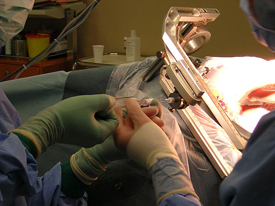 Surgery, a procedure that involves cutting into a patient’s body to access parts beneath the skin, is used to treat cancer in a variety of ways, including diagnosis, tumor removal, or to support a child undergoing cancer treatment.
Surgery, a procedure that involves cutting into a patient’s body to access parts beneath the skin, is used to treat cancer in a variety of ways, including diagnosis, tumor removal, or to support a child undergoing cancer treatment.
The role that surgery plays in the treatment depends upon the type, location, and extent of the cancer. In some cases, the healthcare team may be able to take out a solid tumor. In other cases, chemotherapy or radiation may be used to shrink the size of a tumor so that it can be removed more easily during surgery.
Expand all sections Close all sections
There are two main types of surgery: open and minimally invasive.
Open (or Conventional) Surgery – Surgeons will access a specific part of the body by making an incision (or cut) in the body. Cancerous tumors are often removed through this process.
Minimally Invasive Surgery – Doctors will perform the same operation they would in an open surgery, but do so using small incisions and instruments specially designed to fit through the small incisions. If your child is having a minimally invasive surgical procedure, the surgeon will make a series of small incisions (about half an inch each), rather than one large incision. Minimally invasive surgery is less common for cancer patients than for other types of diseases.
In cancer treatment, surgeries are further classified according to the purpose that they serve in treatment.
Primary surgery – this removes all or most of the tumor at one time. In some cases, the tumor is too big, or is in an area of the body where it cannot be safely removed. In these cases, chemotherapy or radiation may be given before surgery to help shrink the tumor and make it easier to remove.
Second look (exploratory) surgery – this is performed when physicians want to look inside the body to see how well treatments have worked in killing cancer cells. Sometimes, surgeons are able to remove remaining tumor(s) during this surgery.
Supportive care surgery and procedures — these are done to help your child cope with cancer treatments. Examples of supportive care surgery include:
- Putting a central venous line (catheter) into a vein in the chest. The line will allow treatments to be given and blood samples taken without being “stuck” with a needle.
- Putting a gastrostomy tube (G-tube) into your child’s stomach. If your child is not able to take food by mouth for an extended period of time, the G-tube can be used to feed your child until he or she is able to eat food by mouth again.
Most surgeries take place in an operating room under some sort of anesthesia. In the operating room, the surgeon will work with a team of nurses and technicians to prepare your child and perform the procedure. These team members each have specific roles, such as monitoring your child’s blood pressure, heart rate, and breathing, and providing the surgeon with the instruments needed.
Surgeries that are supportive in nature may take place in an operating room or what is known as a procedure room. In a procedure room, the same types of teams support the doctor. You can think of it as a smaller operating room – one in which there is not the same amount of equipment needed because the procedure is much smaller.
Preparing your child for surgery can be challenging regardless of their age. For small children, it is hard to know how much to tell them and how much they will understand. For older children, such as adolescents, understanding more can create more fear. Child Life Specialists will be available at your hospital to help you figure out how to talk with your child in the most appropriate way based on their age.
For most surgeries, children are not allowed to have any food or liquids starting the night before the surgery. On the day of, you and your child will be brought to a pre-operative area close to the operating room. Here, your child will change into a hospital gown and will receive any intravenous or IV medicine needed. The surgeon and anesthesiologist will come and talk with you and your child in the pre-operative area. This is a good time to ask any questions you may have thought of since your last conversation with the doctor.
When it is time for your child’s surgery, you will be taken to a waiting area. It can sometimes feel stressful to wait during a surgery. Try to bring something that you find distracting or comforting, including magazines, a crafts project, a good book, or work to do. After the procedure, your child’s surgeon will find you in this area and talk with you about the surgery. While the doctor is talking with you, your child will be brought to the post-operative area. Here, nurses will monitor your child for a period of time to make sure he or she is feeling as well as can be expected after the operation. The surgeon will also check on your child in the post-operative area.
When finished in the post-operative area, your child will either be brought to a patient room or permitted to leave the hospital with you.
Side effects will differ for patients depending on the operation, tumor location, the child’s health, and other factors. While there is likely to be sensitivity to the area of the body where the surgery took place, the operation and the use of medications to control pain can create these common side effects:
- Constipation
- Headaches
- Nausea
- Pain
